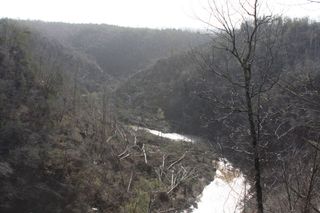
Valleys May Funnel Tornado Winds

Fans of the TV series "Storm Chasers" may be disappointed — not all tornado scientists race after dangerous weather. Some are more like crime scene investigators, only showing up after the damage has been done.
Such forensic experts can learn a lot from studying the aftermath of a fierce tornado, said Christopher Karstens, a meteorologist at Iowa State University in Ames.
Karstens recently traveled to Alabama to survey the toll of a particularly deadly storm, gaining valuable insights into how cyclones behave when they're forced to churn through mountainous territory.
Tornado trail
In April 2011, hundreds of tornadoes ripped through the Southeast U.S., killing more than 300 people. One particularly savage twister, which at one point swelled to about 1.5 miles (2.4 kilometers) wide, careened tore its way 60 miles (97 kilometers) from Tuscaloosa, Ala.60 miles (97 km) northwest to Birmingham, leaving a trail of rubble in its wake. Karstens rushed to the scene not long after. [5 Deadliest Tornado Years in U.S. History]
Like an expert tracker, the young meteorologist followed the footprints of the tornado as it wound through the thick forests near Tuscaloosa. It was tough going. This stretch of Alabama — which sits at the southern edge of the Appalachian Mountains — is marked by steep ridges that rise close to 490 feet (150 meters) high, then plummet into narrow valleys.
But Karstens didn't mind the trek. In fact, he was interested in how tornadoes themselves are able to cross such terrain. Most tornado research, he explained, is done where it's flat — think the plains of Oklahoma or Kansas — but tornadoes don't just touch down on even ground.
Sign up for the Live Science daily newsletter now
Get the world’s most fascinating discoveries delivered straight to your inbox.
"If you talk to people in Alabama, they'll probably tell you that they have tornadoes as frequently as people in Oklahoma," Karstens told OurAmazingPlanet. So far, however, it hasn't been clear how such rugged terrain can affect tornado winds.
Valley vortex
Lucky for Karstens, his cyclone left behind telling clues — namely, snapped twigs and broken branches. The trick was to observe the wreckage, then "try to understand the winds that produced that damage," he said. Karstens discovered during his first visit and several to follow, for instance, that trees lying in low valleys took a much more severe beating than those resting at the tops of ridges. Trees right in the path of the severe winds even had their bark completely stripped off.
Karstens suspects, but can't yet prove, that as a twister drops into a narrow valley, the winds escaping from its vortex may become trapped by the ridges to either side. Then, similar to gusts in a wind tunnel, these rushes of air surge away from the tornado and down the valley — and quickly. That could make such channels a very dangerous place to be during a storm. It's an interesting observation for twister buffs, but it may also help to keep people safe, said Partha Sarkar, a structural engineer at Iowa State and one of Karstens' colleagues. For instance, once scientists know how tornadoes behave in hilly territory, they may be able to warn people living in particularly wind-prone locales, say at the bottoms of valleys.
This story was provided by OurAmazingPlanet, a sister site to LiveScience.
